 |  |  |
| Romanian Army in the Second World War · Forum Guidelines |
 Help Help
 Search Search
 Members Members
 Calendar Calendar
|
| Welcome Guest ( Log In | Register ) | Resend Validation Email |
| Pages: (4) [1] 2 3 ... Last » ( Go to first unread post ) |    |
| dragos |
Posted: May 01, 2004 09:06 pm
|
 Admin Group: Admin Posts: 2397 Member No.: 2 Joined: February 11, 2003 |
Resistance National Movement (1944-1946), Alesandru Dutu, Florica Dobre
Revista de istorie militara, 5/1996, pp 26-32 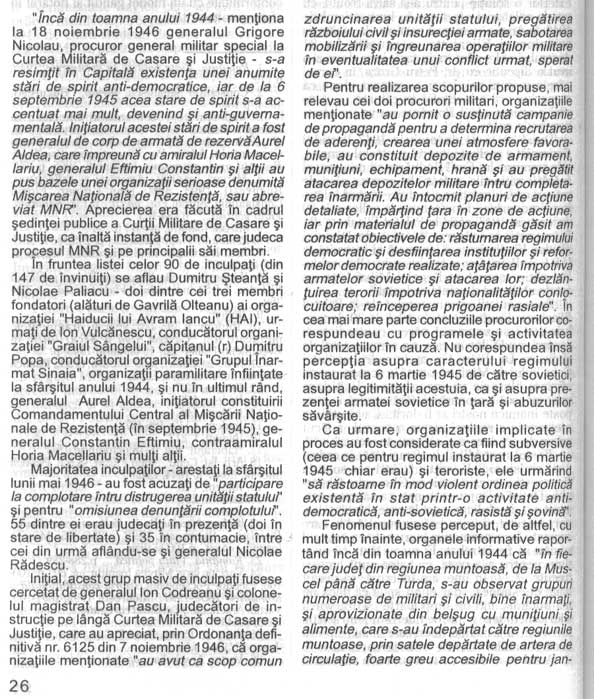
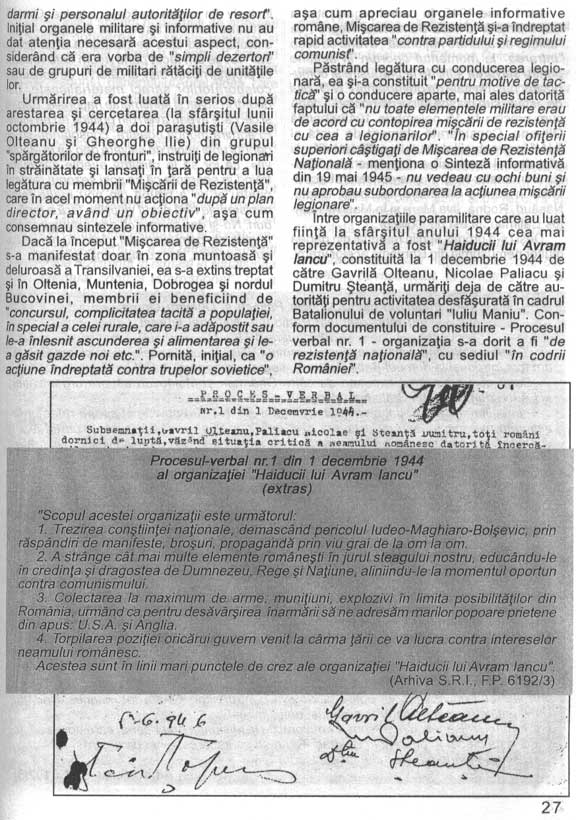
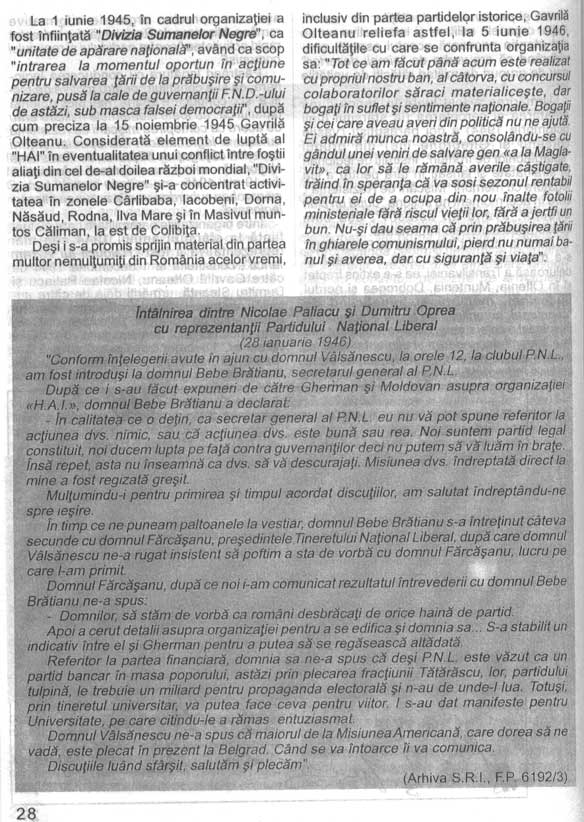

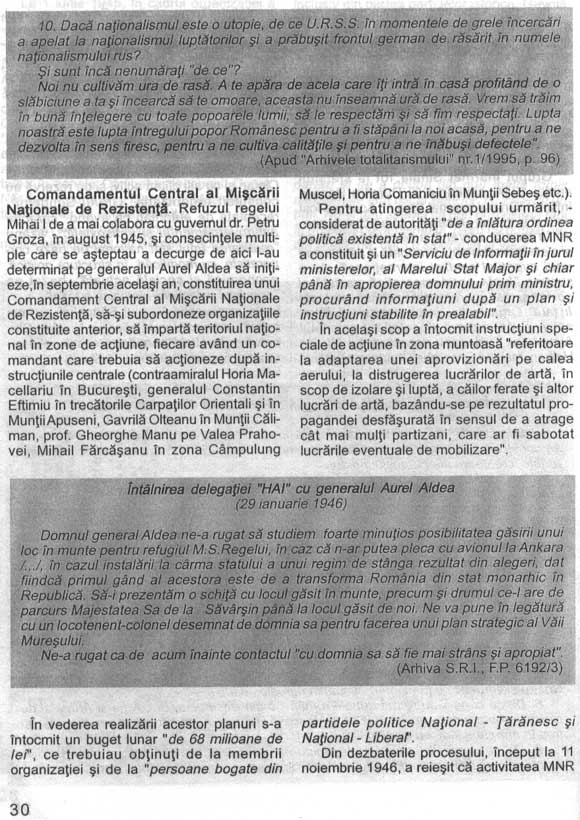
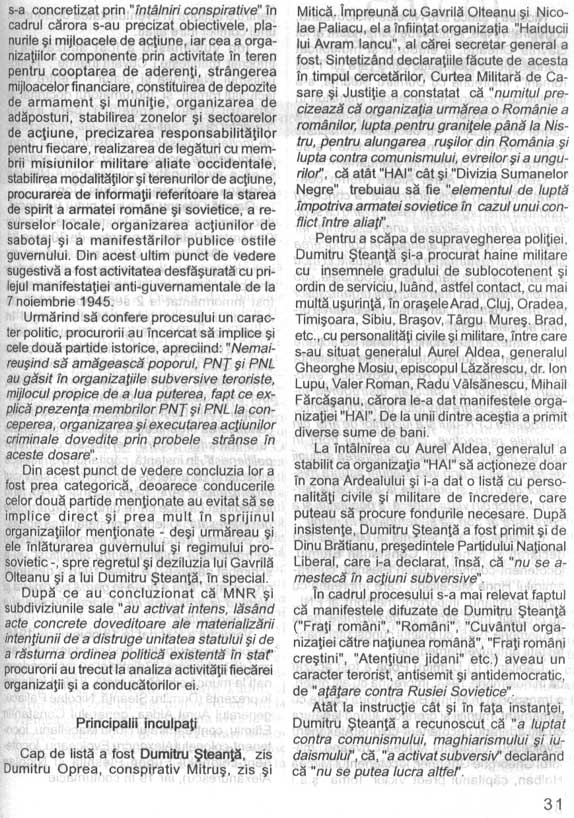
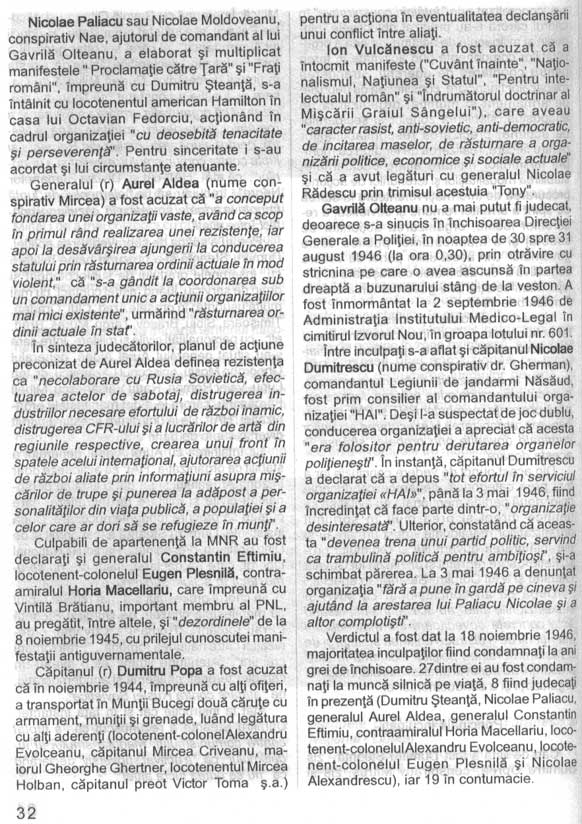 |
| mabadesc |
Posted: May 01, 2004 10:20 pm
|
|
Locotenent colonel Group: Members Posts: 803 Member No.: 40 Joined: July 11, 2003 |
Thanks for posting this info, Dragos! I've always wanted to learn more about post-war anti-communist partisan guerillas or organizations. Unfortunately, there aren't many books which address this issue.
|
| Dr_V |
Posted: May 02, 2004 07:19 am
|
|
Caporal Group: Members Posts: 146 Member No.: 71 Joined: August 05, 2003 |
Thanks Dragos!
Hey, are the foreign members interested by this subject? We discussed a few related topics on this forum. If you are, gentlemen, just post a few replys to let me know: I'll translate the posted Romanian documents right here. |
| Brotherhoodofthecross |
Posted: May 03, 2004 10:38 am
|
|
Soldat Group: Members Posts: 20 Member No.: 223 Joined: February 20, 2004 |
Thanks for the info. Indeed very interesting. It looks that a lot of those who participated to thse movements had something to do with the Legionaries or at least shared some of their philosophy. It is understandable since it takes a bit of fanatism to commit to a movement with such n little chances of success.
|
| Victor |
Posted: May 03, 2004 01:34 pm
|
|
Admin Group: Admin Posts: 4350 Member No.: 3 Joined: February 11, 2003 |
Resistance centers:
1. Bukovina form 29 March 1944 to 1958 2. Sibiu from October 1944 to 1954 3. Maramures from 5 March 1945 to 1958 4. Banat from May 1947 to 1962 5. Arad from June 1947 to November 1958 6. Dobruja from July 1947 to 1956 7. Apuseni Mountains from August 1947 to 1958 8. Bacau from September 1947 to February 1960— 9. Vrancea from June 1948 to 1958 10. Brasov from June 1949 to 1950 11. Bihor from June 1947 to 1954 (also Apuseni Mountains region) 12. Muscel from February 1948 to February 1950 13. Fagaras Mountains from May 1948 to May 1956 14. Neamt from June 1948 to May 1956 15. Hunedoara from July 1948 to June 1949 16. Oltenia from September 1948 to May 1952 17. Bistrita-Nasaud from 1948 to 1950 18. Mures from March 1949 to 1951 19. Cluj from May 1949 to February 1958 20. Bucharest from 1945 to 1957 There were several kinds of "partisans" during the years. The first and most important were probably the groups under the leadership of former officers, like col. Uta, lt. col. Arsenescu, maj. Dabija, lt. Toma Arnautoiu, lt. Teodor Margineanu and others. These groups were the most active and were driven by the hope of the "arrival of the Americans". They attacked and even killed local communists, destroyed PMR centers, sabotaged etc. Then there were the people who chose to flee to the mountains to escape the Communist regime. They did not join with the former military groups (did not generally believe or even care if the Americans would come) and were more "peaceful". But did fight when they were cornered and preferred to live a hard life in the mountains then to live under Communism. The last category was the organizations, which acted as weapons depots and hideouts for people the Communist authorities pursued. They also planned to start sabotage actions in case of a war between the SU and NATO. The main problem of the Romanian resistance was the lack of a unified leadership. The Miscarea Nationala de Rezistenta of gen. Aurel Aldea was unfortunately quickly subdued by the authorities. If it would have succeeded in surviving, it could have been a serious opponent for the DSS, which often lacked the men and professionalism to counter it early in the 50s. |
| 88mm |
Posted: May 07, 2004 07:36 am
|
||
|
Fruntas Group: Members Posts: 54 Member No.: 18 Joined: June 23, 2003 |
These people are actualy peasents wich were economicly cornered by the comunists. Theire fight doesn't have ideological status. Before imposing their agricultural reform (you know CAP-urile) the comunists where colecting a preset amount of agricultural products. These amounts were set due to the amount of land a family had and were the same for those who had land in mountain or hill regions and those who had land in a plain region. That's why this partisans were mainly from regions with a lower agricultural productivity, becouse theire incapacity to fullfil these requests. And one more thing, the families who convert themselves to the Greek Catolic church for more privilieges during the Austro - Hungarian ocupation were owners of biger land properties. This led the autorities to make the Greek Catolic church an outlaw. Because the soldiers who fight these partisans were from peasent families to, led to the loss of people suport for this resistance. |
||
| Victor |
Posted: May 07, 2004 09:28 am
|
|
Admin Group: Admin Posts: 4350 Member No.: 3 Joined: February 11, 2003 |
They weren't only peaents trying to escape colectivization, but also other categories of Romanians hunted by the regime, like the legionaires of the Arnota Mountains Group.
|
| Brotherhoodofthecross |
Posted: May 07, 2004 10:03 am
|
||
|
Soldat Group: Members Posts: 20 Member No.: 223 Joined: February 20, 2004 |
Legionaires had many sins is true, but at least they realised the danger represented by the Red Cancer and fought desperately against it. |
||
| Carol I |
Posted: May 10, 2004 09:29 pm
|
|
General de armata Group: Members Posts: 2250 Member No.: 136 Joined: November 06, 2003 |
A series of articles on the post-war resistance that has been published today in Jurnalul National
Haiducii lui Dumnezeu Razvratitii din padurile Maramuresului voievodal Luptatorii din Tibles Ion Gavrila, cosmarul Securitatii Prabusirea centrului de comanda al rezistentei Singurul supravietuitor: mit in manualul de istorie Aristina Saileanu, eroina in pantaloni din Lapus Eroii din Vrancea: Paragina si Timaru "Vrem doar adevarul" Banatenii au fost fruncea miscarii anticomuniste Carti despre "banditi" Partizanii Dobrogei Haiducul din Babadag Satul de dupa gratii "Cate strazi din sat au numele eroilor?" |
| Carol I |
Posted: May 10, 2004 09:37 pm
|
|
General de armata Group: Members Posts: 2250 Member No.: 136 Joined: November 06, 2003 |
I forgot to mention that the articles are only in Romanian and unfortunately I do not have the time to translate them into English. If any of the foreign members of the forum are interested, I think they will get help with the translation. Dr_V, for example, has already stated his availability in this respect.
|
| Victor |
Posted: May 15, 2004 12:53 pm
|
|
Admin Group: Admin Posts: 4350 Member No.: 3 Joined: February 11, 2003 |
The Arnota Group
It was organized at the end of 1948 by Ion Opritoiu, both had participated in the rebellion in January 1941 and had been imprisoned during the Antonescu regime. The established the camp in the Arnota Mountains (west of the Olt Valley) close to the Arnota and Bistrita monasteries. The men started arriving there from 26 February 1949. These were people trying to escape the system and did not have in mind any actions against the regime. The group was comprised at its maximum by 16 men. These were supported by a network of sympathizers led by Ghita Pele, the third leader, but who stayed in Bucharest. They adopted mainly a defensive attitude. On 23 April 1949, the Securitate, alarmed by their presence in the area, established two observation posts near the camp. One of the posts captured Constantin Ciorgan, who was bringing supplies to the group and later supplied information under interrogation. The other post, however, became prisoner, after the group engaged it. The two Securitate men were tried by a "tribunal" under the leadership of Opritoiu. The decision was to set them free in exchange for their belongings. On 26 April, when the prisoners were about to be released, the group was surprised by a company of the 4th Securitate Battalion and 25 other Securitate agents. Ţhey opened fire and wounded 2 soldiers. 7 of them were killed, 5 were arrested and other 4, including Opritoiu, escaped. Also 6 nouns were arrested for aiding the partisans. Other 48 people were later arrested for supplying them. Opritoiu and Pele were apprehended by September 1949. They were killed apparently in 1950, during transport. |
| 88mm |
Posted: May 21, 2004 09:00 am
|
|
Fruntas Group: Members Posts: 54 Member No.: 18 Joined: June 23, 2003 |
http://pages.prodigy.net/nnita/rezisten.htm That's the willage of my grandparents. Some names are relatives of mine, not close tghou. Note that the second names are the willage nicknames, it's also the name that tell's you who you are related with. My granmothers father escaped because he was to new in the organization and he didn't apear on any list.
|
| mateias |
Posted: December 11, 2007 11:14 am
|
|
Sergent Group: Members Posts: 169 Member No.: 1704 Joined: December 02, 2007 |
For Victor,
I think you made a mistake as regards resistance in Muscel county. The group led by Arnautoiu brothers lasted till 1958 when captured by betrayal. Toma Arnautoiu's daughter, Ioana Raluca Voicu-Arnautoiu, wrote a huge book on this subject (Securitate called "gangs of thugs" all the resistance groups). |
| Victor |
Posted: December 11, 2007 06:21 pm
|
|
Admin Group: Admin Posts: 4350 Member No.: 3 Joined: February 11, 2003 |
Correct it is until February 1960, not 1950
|
| Jeff_S |
Posted: December 19, 2007 07:35 pm
|
||||||||
|
Plutonier Group: Members Posts: 270 Member No.: 309 Joined: July 23, 2004 |
I'm surprised I didn't notice this thread before. An interesting topic in my opinion. I find the length of time some of these movements lasted as amazing. Victor described some of the motives of anti-communist resistance. Can anyone expand on this?
As an American I can say that was totally hopeless, although I know there was some encouragement given to this sort of resistance in Eastern Europe... (shamefully, IMHO, as we had no intention of attacking into Eastern Europe to support them). Can anyone speak to how these partisans decided this was the best course of action? Did they underestimate the strength or ruthlessness of the Soviets and their local supporters? Did they overestimate their own strength? Did they really expect the Americans to drive up and rescue them? Or were they so hopeless that they just felt they had nothing to lose, and would rather die honorably fighting for a lost cause?
I know some parts of Romania are very rugged terrain and isolated. But were there parts where the government (communist or otherwise) truly doesn't reach? It's not that big a country, and the Soviet's client states in Eastern Europe don't have a reputation for "live and let live" toleration of semi-independent communities inside their own borders. How did they survive? Farming? (that requires staying in one place at least for one growing season) Parasites off of settled communities? (stealing, gifts from sympathizers) That means they must be in contact, and exposes them and their sympathizers to retaliation. Hunting and gathering? Could people really just "be left alone" provided they stayed on the margins of society and didn't pose a political challenge?
Weren't these awfully vulnerable to infiltration, or being "rolled up" following the arrest of 1-2 members? Without any ability to communicate other than face to face, and not knowing who you could trust, how could such an organization even get established? |
||||||||
1 User(s) are reading this topic (1 Guests and 0 Anonymous Users)
0 Members:
 Pages: (4) [1] 2 3 ... Last »
Pages: (4) [1] 2 3 ... Last » |
   |
[ Script Execution time: 0.0336 ] [ 14 queries used ] [ GZIP Enabled ]
Powered by Invision Power Board(U) v1.3.1 Final © 2003 IPS, Inc.






